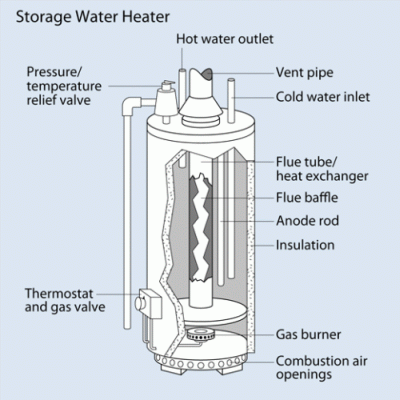Hot Flushes, Draincocks and Sacrificial Rods
There are few things I find more refreshing than a hot shower. Because I set the shower water temp cooler in the summer I didn't notice that the hot water wasn't quite as hot anymore. With crisp fall temperatures suddenly the warmish shower was obvious. I took advantage of a warm, clear day (after everyone had their bath or shower) to flush the sediment out of the water heater and return it to full heat.
If you've never flushed a water heater, don't worry, this is actually a simple DIY task. Here are the basics of flushing a tank-style water heater:
- Turn off the water heater. Shut off the power to an electric water heater and turn gas water heaters to pilot mode
- Shut off the cold water supply to the water heater. There should be a simple handle valve on the cold water supply pipe that you turn 90° to the direction of the pipe.
- Open a hot-water tap close to the water heater. I also opened the safety relief valve on top of the water heater to help speed the draining of the tank.
- Open the draincock located near the bottom of the water heater. Depending on where your water heater is located you may need to attach a garden hose to drain the water downhill toward a drain or outside.
- Refill the tank. I needed to fully fill and drain the water heater with cold water to fully flush the sediment.
- Close the draincock, Remove the garden hose, Close the hot-water tap, Open the cold water supply valve, Turn on the water heater power or switch the gas valve back to on.
Notes:
- Simply draining the water heater once did not clear the sediment in the tank, it required refilling and draining a second time to clear the calcium and particulates.
- I directed the drained water to thirsty plants in the yard.
- Draining the water heater tank is a slow process, find something else to do while you wait.
- Opening the Temperature Relief Valve (safety relief valve) speeds up draining the water heater tank slightly.
- After refilling and turning the water heater back on, you will need to purge the air in the pipes leading to the tap you opened to help drain the tank. You will likely get a lot of air and some sediment from the faucet before the water runs clear.
Unfortunately, I was unable to remove the sacrificial anode rod to check if it is still good. Our utility closet is small and the anode rod was pretty well stuck in the water heater. I'm researching how to remove a stuck water heater anode rod. So far, it sounds like 'brute force' may be the only effective way to un-stick the anode.
Eventually, I intend to replace our water heater with a more efficient option. Solar water heaters appear to be the most efficient to operate, but they aren't inexpensive to buy. Until then, we have hot showers back on tap all for relatively little hassle.
More Info:
EnergySavers.gov - Selecting a New Water Heater
Consumer Reports - Flush your water heater
This Old House Video - How to Flush a Water Heater
This Old House Video - How to Change a Water Heater Anode Rod


